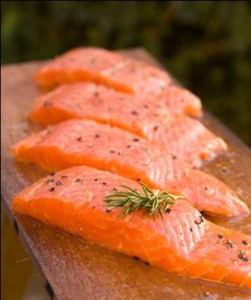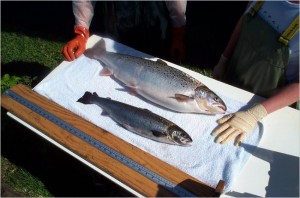Dr. Strangelove’s Salmon
 It takes three years for a salmon in the Atlantic to reach full size. But if you find a way to mix in genes from an ocean pout (a kind of eel), you’ll have the salmon grow in half that time — and to giant super-plus size. No wonder the fish farm businesses are licking their gills in anticipation.
It takes three years for a salmon in the Atlantic to reach full size. But if you find a way to mix in genes from an ocean pout (a kind of eel), you’ll have the salmon grow in half that time — and to giant super-plus size. No wonder the fish farm businesses are licking their gills in anticipation.
The U.S. Food & Drug Administration is leaning toward giving these franken-salmon the fins-up in the next year.
Questions: What happens to the ocean ecology when (not if) one or more frankenfish escape into the ocean and start to breed? (The developers say they’ll be sterile. But really?)
And are they safe to eat? The developers say yes. (Like BP said the Deepwater Rig was safe.)
Genetically modified animals are the unholy grail of the food industry. Other projects underway include modifying pigs so they can digest less digestible food. (What will be the effects on our own digestion?)
 Farmers and gardeners have been mixing up genes for hundreds of years by selective breeding. But no one knows the long-term effects when you start doing this artificially. Most of the corn and soybean crops are genetically modified. They’re designed to be resistant to bugs. But with the elimination of genetic diversity, we’re stuck with one single strain. So when (not if) the bugs mutate, the entire crop can be wiped out, and there’s nothing to fall back on.
Farmers and gardeners have been mixing up genes for hundreds of years by selective breeding. But no one knows the long-term effects when you start doing this artificially. Most of the corn and soybean crops are genetically modified. They’re designed to be resistant to bugs. But with the elimination of genetic diversity, we’re stuck with one single strain. So when (not if) the bugs mutate, the entire crop can be wiped out, and there’s nothing to fall back on.
Genetically modified foods (meaning fooling around with the animals and nature in the laboratory) are an accident waiting to happen.
They also constitute cruelty to animals.
Read about the Atlantic salmon in the London Telegraph.
